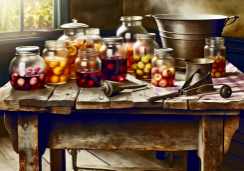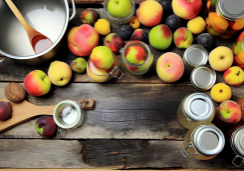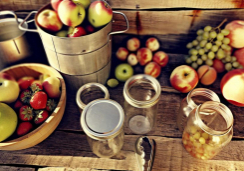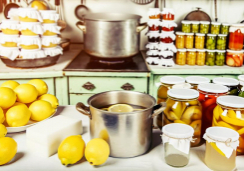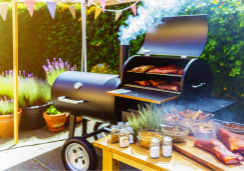Essential French Cooking Techniques for Home Chefs
Imagine you're standing in a bustling Parisian bistro kitchen, your senses alive with the aromas of simmering sauces and fresh herbs. You've watched in admiration as the chef, with a flick of the wrist, transforms simple ingredients into a culinary masterpiece.
As a home chef, you too can harness these essential French cooking techniques to elevate your dishes from mundane to magnifique. The secret lies not in expensive equipment or exotic ingredients, but in the mastery of foundational skills like making a perfect roux, emulsifying a vinaigrette, or crafting the five mother sauces.
The key question is, how can you apply these time-honored methods in your own kitchen to create dishes that whisper tales of Provence and the Riviera? Let's embark on a journey through the core principles of French cuisine that are within your reach, transforming your meals and perhaps even the way you think about cooking.
Mastering Mirepoix Basics
Frequently dubbed the backbone of French cuisine, mirepoix is a simple yet essential trio of vegetables that you'll chop and sauté to create a deeply flavorful foundation for an array of classic dishes.
As you embark on the journey of basic French cooking, mastering mirepoix is a technique that elevates your cuisine by infusing it with rich, aromatic flavors.
Your mise en place, the methodical organization of ingredients, will be incomplete without the finely diced onions, carrots, and celery that comprise mirepoix.
As you heat your pan, consider the cooking time – a gentle sauté is crucial to coax out the vegetables' sweetness without browning them, as this base isn't just about taste but also about creating a harmonious blend of flavors.
Imagine the kitchen brigade efficiently moving through their stations, each cook preparing their own mirepoix, the air filled with a savory scent that's the hallmark of French culinary tradition.
As you stir the vegetables, think of the bouquet garni, another aromatic contributor, and how these elements form the soul of your dish. Each stir, a step closer to achieving the essence of French cooking – a celebration of flavor and technique.
Perfecting the Art of Roux
Diving into the heart of French sauce-making, you'll find that mastering a roux—a simple blend of flour and fat—is essential for crafting the rich, velvety textures that define many classic dishes. This cornerstone technique, taught early in French culinary education, serves as the starting point for the renowned mother sauces in French cuisine.
To make a roux, you'll start with equal parts flour and fat—often butter, though clarified butter is a favored choice for its higher smoke point and pure fat content. The process begins by melting the fat, then adding the flour. You must whisk constantly to prevent clumping and ensure a smooth, consistent mixture.
The color and flavor of your sauce hinge on the roux's stage: blonde, brown, or dark. A blonde roux is cooked just until it emits a toasty aroma, while a brown roux, used in richer sauces like Espagnole, acquires a deeper hue and nuttier flavor.
Crafting the Five Mother Sauces
Embarking on the journey of French cuisine, you'll soon discover that the five mother sauces—Béchamel, Velouté, Espagnole, Hollandaise, and Tomato—are pivotal to mastering the art of French cooking, each serving as a foundational element for a myriad of sophisticated sauces and dishes. These sauces, perfected by legendary French chefs, form the backbone of the culinary arts in French cuisine.
With Béchamel, you're crafting a creamy base using flour, butter, and milk, essential for a comforting lasagna or an indulgent macaroni and cheese.
Velouté, a smooth union of white stock, mirepoix, and a blonde roux, elevates soups and creates sauces with a velvet touch.
Espagnole, or the rich brown sauce, brings together brown stock, tomato paste, and a brown roux, offering concentrated flavors to beef stroganoff and hearty gravies.
As you delve into creating sauces, remember that a small amount of Hollandaise—an emulsification of egg yolks, butter, and lemon—can transform vegetables and eggs into exquisite fare.
Lastly, the vibrant Tomato sauce, simmered to perfection, is versatile, enhancing everything from pastas to stews.
Master these five mother sauces, and you'll unlock the secrets to countless culinary creations, each with the power to transport your taste buds to the very heart of French gastronomy.
Implementing Delicate Knife Skills
To truly excel in French cuisine, you'll need to hone your knife skills, ensuring each delicate cut contributes to the dish's visual appeal, texture, and flavor. The art of French cooking is deeply intertwined with the precision of slicing and dicing. Your modern kitchen becomes a studio where every movement is intentional, and everything in its place.
Implementing delicate knife skills means transforming ingredients into small pieces that not only look beautiful but also cook quickly and evenly. Here are some key techniques to master:
- Julienne: Cutting into long, thin strips, perfect for stir-fries or garnishes.
- Chiffonade: Rolling leafy vegetables and slicing them perpendicular to the roll for delicate ribbons.
- Brunoise (small dice): Creating tiny, uniform cubes that enhance texture in refined dishes.
- Batonnet: Achieving slightly larger, stick-shaped pieces ideal for elegant vegetable sides.
- Paysanne: Slicing vegetables into thin, flat pieces that complement rustic French stews.
Each slicing technique requires a steady hand and a sharp knife. Remember to maintain your knives to preserve their edge and your safety.
As you practice, your knife skills will elevate the dishes you create, embodying the finesse that French culinary tradition celebrates.
Embracing En Papillote Method
Stepping into the world of French cuisine, you'll discover the en papillote method, a technique that wraps your favorite proteins and accompaniments in parchment or foil, transforming them into tender, aromatic delights. This cooking method seals in moisture and enhances the flavor without browning, making it perfect for delicate proteins such as halibut, trout, chicken breast, and pork chops.
Imagine placing a beautifully seasoned piece of fish atop a bed of thinly sliced vegetables, maybe adding a spoonful of vegetable coulis for an extra burst of flavor. When you encase this assembly in parchment paper and subject it to high heat, the packet puffs up, steaming the contents in their natural juices. This method, used in French culinary schools, imparts a complexity of flavors that's hard to achieve through other cooking techniques.
The beauty of en papillote isn't just in the taste. It's also in the presentation and the ease of cleaning up. Once your guests slice open the parchment, they're greeted with a cloud of fragrant steam and a perfectly cooked, moist meal.
French Cooking Techniques like this turn your kitchen into a gourmet haven, proving that with a little know-how, you too can create dishes that are both elegant and effortless.
Frequently Asked Questions
What Are 5 French Cooking Techniques?
You're curious about French cooking techniques? Dive into mirepoix preparation, master roux basics, sauté vegetables to perfection, poach eggs effortlessly, and create succulent confit. They'll elevate your meals with a touch of French finesse.
What Are the Fundamentals of French Cooking?
You'll need to master the mirepoix basics, perfect your roux variations, and achieve consommé clarity. Learn the en papillote method, chiffonade skill, bain-marie usage, julienne cuts, beurre manié, clarified butter, and court bouillon preparation.
What Is the Secret of Food French Cooking?
The secret to French cooking lies in mastering techniques like perfecting mirepoix basics, experimenting with roux variations, and achieving sous vide precision. You'll excel with chiffonade cuts and quenelle shaping for elegance.
What Are the Keys to French Cooking?
The keys to French cooking include mastering mirepoix, butter sauces, wine reductions, and herb infusions. You'll excel with techniques like en papillote, choux pastry, consommé clarifying, court bouillon, sous vide precision, and caramelization.
Conclusion
You've now got the essentials of French cuisine at your fingertips. From the precision of your knife skills to the finesse of a flawless roux, you're ready to delight with rich sauces and perfectly seasoned dishes.
Embrace these techniques; let them guide you to create sumptuous meals that speak of care and tradition. Cook with confidence, knowing each step, from mirepoix to en papillote, weaves a bit of France into your kitchen tapestry.
Bon appétit!




